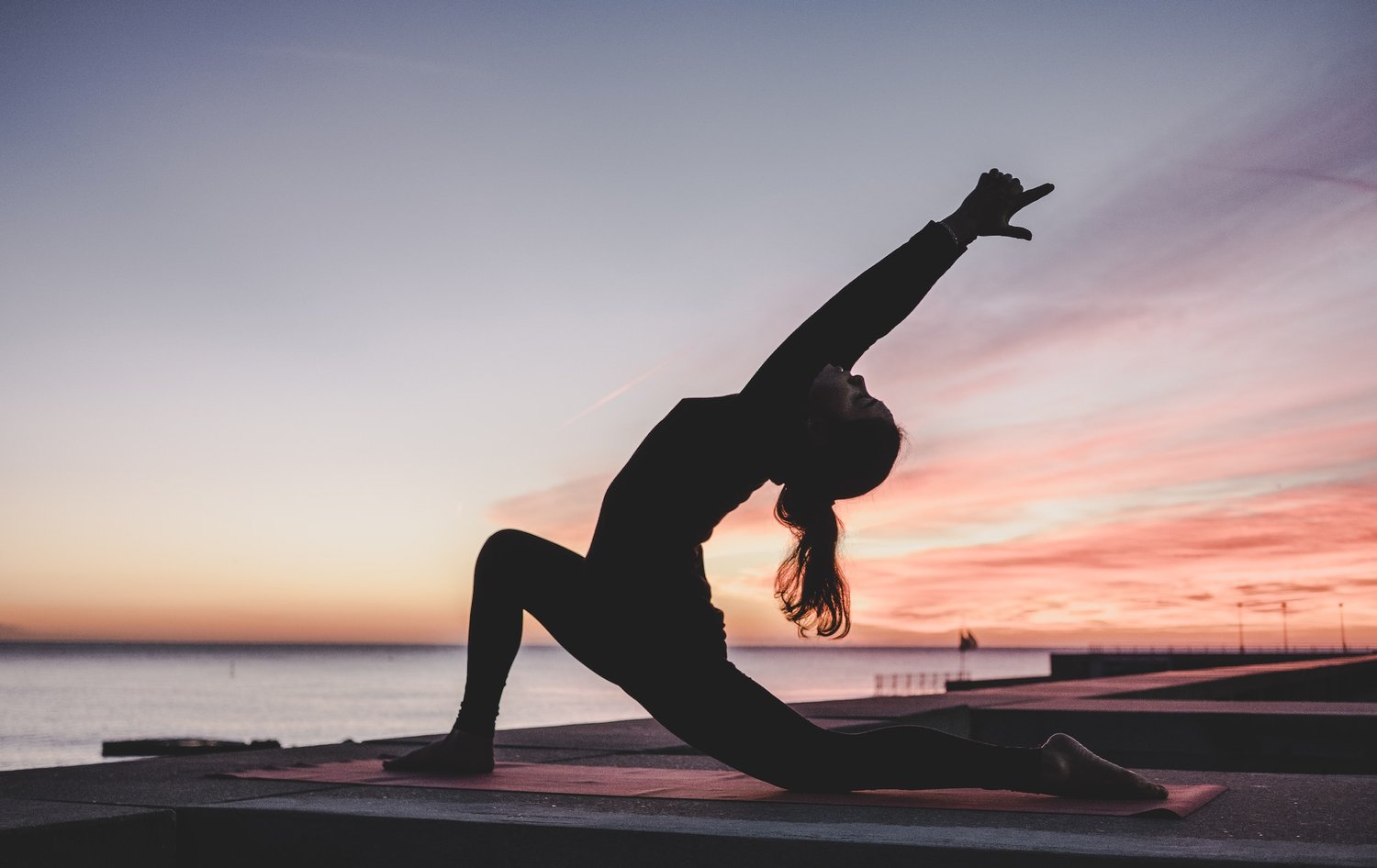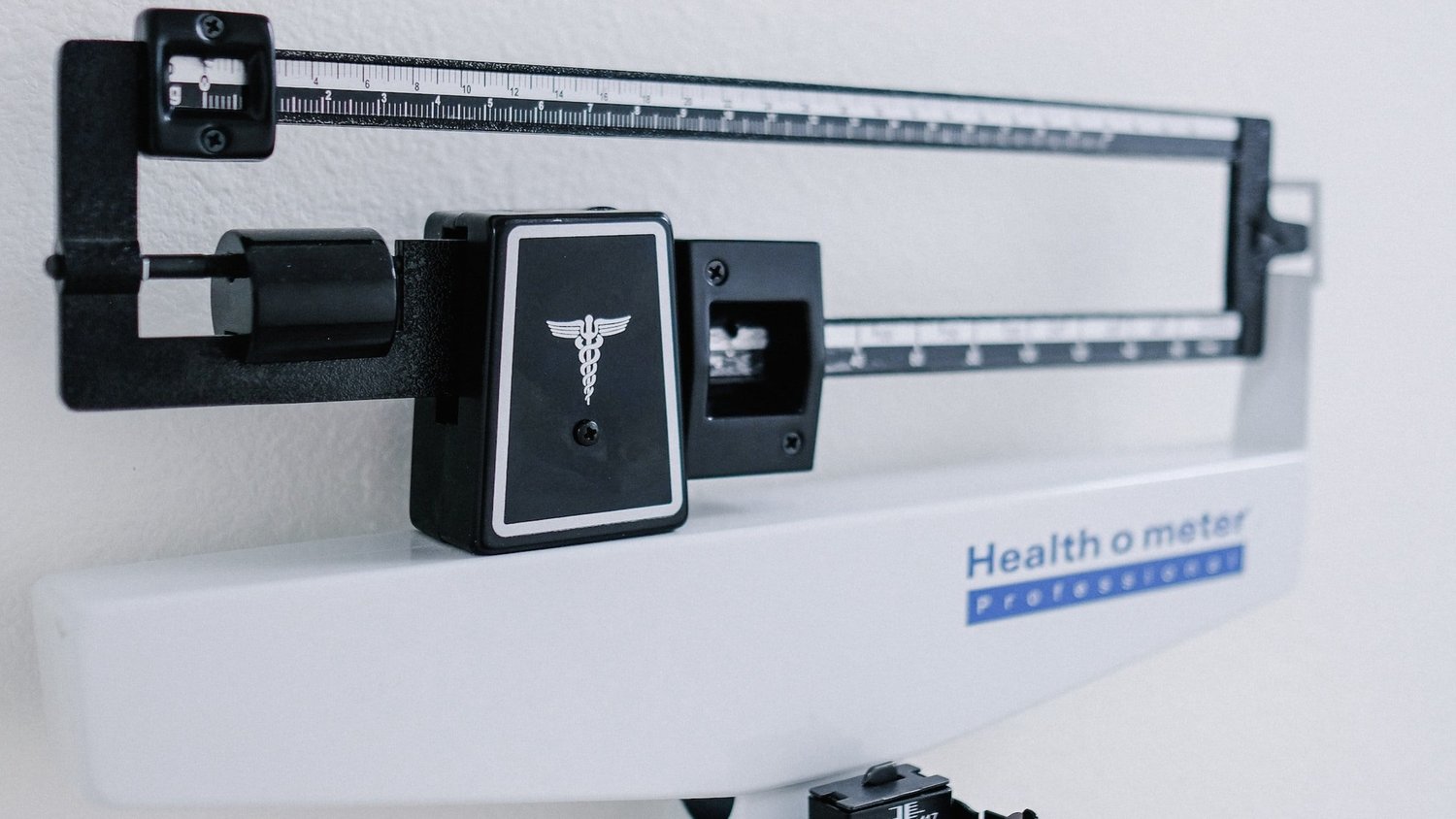at a glance
What Exercise is Best for Polycystic Ovarian Syndrome (PCOS)?

Exercise is considered a “first line” of treatment to improve PCOS symptoms. (1) Let’s take a deep dive into WHY exercise is so important. We’ll get into the nitty-gritty of the newest research for PCOS and what it tells us about how exercise can benefit our health.
Exercise is a First-Line Treatment for PCOS
You all know that I’m a dietitian, so of course I think food is medicine. Nutrition is a first line of treatment for PCOS, but so is exercise. Exercise is one of the most important lifestyle changes you can make to improve overall health with PCOS. It can also impact your symptoms, energy, mood, and even cycle regularity.
Our body uses energy in lots of ways, to make your heart pump, hair grow, brain think, and so much more. Exercise and movement encourage our metabolism to burn off the energy (food) we give our body instead of storing all of that energy as fat.
Thankfully, most of us do not need to store too much energy. We have the food resources we need when we need them. We can head over to the grocery store or farmer’s market, we can order Instacart or UberEats, or we can swing by a fast food drive-thru. There are so many ways for most of us to get food. Because of this, we do not need to store energy in our body. This would be different if food were scarce or we didn’t know how or where our next meal was coming from.
Physical activity is a normal part of the human experience. For millennia we have hunted, farmed, churned our own butter, and ran from predators. Our modern society, culture, work environment, food production, screen-based culture is incredibly divorced from the type of physical activity of our ancestors.
When we remove the normal physical activity for food sourcing, building our own shelters, farming – we need to find ways to replace that even though we may not do those activities any longer.
Some storage of energy is beneficial for us even though we don’t live a lifestyle similar to our ancestors. We need a cushion for our organs, fat cells to make hormones, and storage of energy in case we get sick.
Excess adipose tissue can actually create hormonal imbalances. Fat cells are metabolically active, which means they make hormones and other molecules like inflammatory chemicals. If we have too much fat storage, our hormone levels are impacted and cause inflammation and an overabundance of hormones. That’s one of the big reasons why we need to exercise, we need to use the energy (food) we consume instead of storing what we don’t need. Exercise plays a role in weight maintenance, but there are so many more benefits of exercise other than just using excess energy!
What are the benefits of exercising for PCOS?
Exercise can help women with PCOS with many symptoms. Exercise supports our body to have metabolic flexibility, improves fasting insulin and glucose, manages a healthy weight, fights off depression/anxiety, clears out excess androgens, and helps us send signals to our brains when to eat and when to stop eating. That’s a LOT of benefits and there are even more than that! Let’s talk about each of these.
Exercise Increases Metabolic Flexibility
Exercise allows us to have “metabolic flexibility” which means we can transition easily from a fasted state (like, when we’re sleeping for hours) to a fed state (breakfast). Women with PCOS tend to have “metabolic inflexibility”. (2) That means our bodies struggle to use stored energy (fat) in times of fasting or exercise. It is believed this is in part related to higher levels of circulating insulin.
Have you been the person who did the diet perfectly and exercised all the time and still didn’t lose any weight? This may be why!
Exercise, over time, can help with metabolic flexibility, allowing your body to work with you in times of fasting and exercise to use your stored energy (fat tissue) instead of trying to pull from only the glucose levels in your blood. Exercise helps our bodies to know we can burn those calories (aka energy, food) instead of hoarding them in our storage units (aka fat cells, adipose tissue).
Metabolic inflexibility is dangerous because it has been linked to insulin resistance and type 2 diabetes. But, that’s where exercise can help. Exercise allows our body to burn higher amounts of energy even when we are in a rested state. So, that walk you went on earlier, that’s helping you RIGHT NOW! That’s why it’s important to keep at it. Exercising regularly is the goal!
Exercising regularly helps increase metabolic flexibility, so you can use fat tissue during overnight fasts and exercise. This will help those of us with PCOS obtain a healthy weight over time.
Exercise Improves Fasting Insulin and Fasting Glucose Levels
Glucose and insulin work closely together, like BFFs. We need insulin to tell most of our cells (muscle, liver, and fat cells) to take glucose into the cell and convert glucose to energy. If glucose cannot enter the cell, the cell cannot make energy. Insulin is like a house key that opens the front door for glucose welcoming it inside. Without insulin showing up, glucose cannot go inside. So, we need BOTH!
I’d like to interject here – because many women with PCOS struggle with insulin resistance it can become normal to build a negative attitude toward insulin. However, without insulin, we can’t live. If your body stopped making insulin you would need to inject yourself with it or you would die. We NEED insulin. We just don’t want too much of it.

Women with PCOS have trouble with this lock-and-key situation. Insulin shows up with a broken key and cannot let glucose inside the cell door. The body’s solution is to make more insulin. Over time this response hurts more than it helps.
Here is the great news: exercise comes to the rescue! When exercising, the locks become more sensitive so we don’t need as much insulin to open the cell door! When we exercise, our cells become more sensitive to insulin, allowing glucose to go right inside the cell, it keeps the door wide open so that you can use all the energy for this increase in activity. (3)
When women with PCOS exercise regularly, they have improved insulin and glucose levels all the time, not just during an exercise session. This is so helpful for all of our PCOS symptoms: inflammation, energy, weight, hormones, menstrual cycles, ovulation, and fertility. (4)
Why is it so much more difficult to lose weight with PCOS?
Growing up I had a friend named McKenzie. She could eat whatever she wanted and was as thin as a rail. I remember looking at her body and wishing I had her metabolism. I didn’t really know what a metabolism was, but I knew I could not eat like her and have a healthy body.
When I was diagnosed with PCOS it was after a short period of time with a large amount of weight gain. Through research, I found that women with PCOS burn less energy at a resting state. Meaning at times of rest my friend and yours are burning many more calories compared to you and me.5 In other words your resting metabolic rate, what your body would need to keep your heart pumping and kidneys filtering blood and so on is lower than someone without PCOS.

That means that women with PCOS have to work harder than others to burn excess calories. This is incredibly frustrating but, it’s a truth we need to recognize and strategize based on.
Physical activity can level the playing field for us. When we exercise, we burn more calories when we are in a resting state than when we do not exercise regularly. So, the more you exercise, the more calories you burn when you’re not exercising. This helps our bodies feel safe to use excess stored energy (fat). Women who exercise regularly have a reduction in fat mass and waist circumference. This true in women with AND without PCOS. (5)
Can regular movement and exercise impact my mental health with PCOS?
There have been a lot of studies that show us that women with PCOS have a higher prevalence of anxiety, depression, and negative body image. A meta-analysis reviewed 11 research studies(a meta-analysis is just a fancy term for a group of scientists that group together studies and try to draw conclusions based on multiple studies versus just one) that looked at exercise and how it relates to improvements in health-related quality of life in women with PCOS. (6)
These studies showed that exercise had a positive impact on health-related quality of life and had significant improvements in depression and anxiety symptoms. That means exercising helps us to be happier! Um, yes, please! We don’t need to stay stuck in these feelings of anxiety, depression, and negative body image. Exercise can help us climb out of that valley and offer hope to feel calm, positive, and at peace with our bodies.
I think if you are someone that personally struggles with these mood-related issues (like me), consider reframing the idea of exercise to get started. It’s just a way to enjoy nature, on a nature walk. It can be a time to hang out with a friend, instead of going and sitting at a coffee shop take a stroll around a lake.
I’ve even started doing work meetings on my bluetooth headset while I walk around my neighborhood. Movement is the goal, increased heart rate and sweat (eventually). So start small and do something that is realistic for you today.
My experience with anxiety and medical advice to start exercising
That seems like a magic pill though, right? When you are depressed or anxious, no one wants to be told to just go exercise more, or exercise at all.
I saw a physician after my 3rd child was born and told them I was struggling with anxiety and needed help. The physician told me to exercise for 150 minutes per week. That is not something I was capable of doing at that time.
Hear me when I say, I understand if you are struggling with anxiety or depression – I know how hard it is to have the physical energy or mental fortitude to”start”. I needed to have support from medicine to help me handle my life responsibilities – eventually, I was able to think of exercise and consider doing it.
How does exercise affect hormones in polycystic ovary syndrome PCOS?
While exercise has many benefits for PCOS some of the best benefits have to do with physical activity’s effect on hormones. Exercise has the ability to improve both hunger hormones, insulin and androgen levels.
Can exercise help lower androgen levels in PCOS?
Yes! Exercise has many ways of improving androgen levels.
In a 16-week study with 126 PCOS women exercising three times per week there was evidence of significant improvement in androgen levels.(1) At the start of the study the women’s exercise program included working out for 30 minutes – three times each week, 30 minutes. By the end of the 16-week study they had slowly increased to 50 minutes in the last week.
At the end of the study, women had lower testosterone levels at the end of the 16-week study. I often get asked: How can I improve my PCOS symptoms? There are many answers to this question but in the context of this article – exercising as little as three times per week can help improve lab markers AND symptoms.
Is there an advantage to having higher levels of androgens for exercise?

You guessed it! Yes.
One of the most difficult things to grapple with in terms of our PCOS diagnosis is the physical symptoms that come from high levels of androgens. Did you know these higher levels of androgens can play to your advantage with physical activity?
Higher levels of testosterone can help signal to your body that you can create more lean muscle tissue (and strength). Lean muscle is incredibly metabolically active – meaning it needs a lot of calories to continue to maintain itself. When a hormone does its job in the body, signaling something, the levels of that hormone go down.
With strength training exercises you effectively “use up” the testosterone and other androgens so they don’t tell your ovary not to ovulate or the skin on your chin and neck to grow.
The type of exercise that will “use up” a lot of these excess androgens is weight resistance activities and strength training. These can be body resistance activities like yoga, pilates, or even push-ups and squats. If you want to learn more about this check out the article on increasing your BMR for weight loss with PCOS.
How can exercise improve hunger and satiety hormones?
It’s hard to lose weight if you are hungry all the time. Exercise isn’t the only thing that goes into weight loss, energy consumption matters too!
Women with PCOS have higher androgen levels (male hormones) than women without PCOS. High androgen levels have a lot of negative effects on women and making us hungrier is one of those effects. 5 Other people get full after eating but it takes us a longer amount of time and more food for women with PCOS to feel that same feeling of satiety.
Exercising allows us to produce more hormones that help us feel that ‘fullness- feeling’. Exercise also helps our bodies to produce hormones that allow us to be satisfied for longer periods of time so that we’re not thinking about food ten minutes after we ate.
Exercising helps to regulate our appetite, increasing the sensitivity to satiety signals (that feeling of being full). We need certain hormones to be released in our stomach to know we are hungry and full, and we need those hormones to be received in our brains. There are so many places where this can go wrong but regular physical activity helps to keep it all in working order! Isn’t that neat?!
If you are someone who has ever struggled with not feeling full after meals, consider getting physically active as a way to help reconnect your body to its own signals.
What exercise is best for PCOS?
All exercise is good, let’s start with that. Any time you move your body, that’s awesome. Please do not think that if you don’t exercise a certain way, like running a marathon or going to the gym, that it doesn’t count. Current fitness levels do not need to hold you back from starting today.
It does! Any type of physical activity is good for us, so don’t discount those everyday movements like walking to the mailbox, or picking up a toddler, or pushing a heavy shopping cart.
Every movement is good for maintaining strength and flexibility. The old adage, “use it or lose it” is very true. If you stay in bed all day, it’s going to be difficult to get out of bed. I’m sure we’ve all experienced this. After being sick, getting out of bed seems like such a chore. But, if we allow ourselves to stay in bed, then that’s what our bodies will get used to. So, try to move as much as you can.
If you enjoy the movement activity you are more likely to stick with it. So, choose an activity you enjoy! Do you like connecting with people? Choose an activity like pickleball, tennis, or volleyball. Do you prefer to be alone? Pick out a YouTube exercise video that fits your time constraints and resources. There are so many exercise videos on YouTube that do not require any equipment. If you’re just getting started, you can even find videos of simple movements for just getting started or coming back from an injury or sickness.
Start slow and then increase the activity. If you are gung-ho right away, you might get discouraged or get injured. Start slow and focus on doing something that makes you happy. Focus on the joy it brings you and how your body feels afterward. If it doesn’t bring you joy, you are less likely to stick with it.

Studies of PCOS women show that there is a beneficial effect from even a moderate amount of physical activity.5 Even if you aren’t losing weight from exercise, it still has beneficial effects. Aerobic exercise (that’s an exercise that makes you breathe heavily) has shown to be beneficial in women with PCOS by improving body composition, lipid profile(cholesterol and triglyceride levels), and weight loss compared to resistance training.
This study compared women with PCOS who exercised using High-Intensity Interval Training (HIIT) with others who exercised with Continuous Aerobic Exercise Training (CAET). (7) It showed that both groups had improved health. This confirms my point, it doesn’t matter what you do, it matters that you do it.
Yoga has shown positive results in studies with PCOS women. If you’ve ever considered trying yoga, I encourage you to do so. You don’t have to be flexible or super fit. Yoga is great because it connects us to our breathing which is something we usually don’t think about. If you practice yoga for just 6 weeks you can expect to notice a significant improvement in your fertility.(8) In a meta-analysis looking at 11 studies of women with PCOS who practiced yoga, they found an improvement in menstrual cycle regularity, metabolism, and overall quality of life. (9) Yoga has proven to be beneficial for every type of person, in every population.
People who lift weights may argue that resistance training is the best way to exercise. There is a lot of noise in this regard in the influencer world. Others argue that slow-weighted exercises are the preferred exercise.
There is no competition. Let’s just make it our goal to find movement that we enjoy. This may change depending on what season of life you’re in or even the weather outside and that’s okay! Find what works for you right now and do it! Grab a friend and encourage them to go with you. If someone is planning on meeting you or waiting for a ride to the gym, or if someone is waiting at the tennis court for you, you’re much more likely to go!
How often should I exercise with polycystic ovary syndrome (PCOS)?
The research points us to helpful and non-helpful amounts of exercise. Physical movement is good for you, but like everything you can do too little or too much – moderation is key.
Exercise should be closely related to your energy intake, so, if you eat more in a day, you could move your body more that day or the following day. If you don’t eat much, then ease back on physical activity until you are able to eat more.
You need to make sure you’re eating enough to have the energy to exercise. Just like everything else in your life, it changes depending on what’s going on. If you’re sick, you eat less and move less. This is the way our bodies function.
When we are more active, we need fuel for that activity. Try to look at your activity in 24-hour increments and match your energy intake with your energy expenditure for the healthiest balance.
Studies have shown that shorter duration moderate activity is better tolerated and shown to provide improvements more consistently and for a longer term. 5 Moderate exercise is anywhere between 30 to 60 minutes each day. Moderate-intensity exercise is best if spread evenly throughout the week, even daily if you can! If you want to do more vigorous intensity activities, that’s totally fine, just try to space them out by a day.

Avoid excessive exercise, over an hour, every day. Unless you are training to be in the Olympics, this amount of physical activity is unnecessary and tends to lead to adverse effects like anovulation and injury. So, let’s avoid getting discouraged if we can and just stick to a moderate amount of exercise.
Basically, you don’t want to overdo it. Since anovulation (a lack of periods) is common with over-exercise and is also a symptom of PCOS, you should avoid anything that is known to stop you from ovulating. You should avoid exercising excessively, greater than 60 minutes each day, in order to avoid the risk of anovulation.
Can Exercise Improve Fertility with PCOS?
Two of the most predominant reasons women with PCOS struggle with getting pregnant are chronically high levels of insulin and androgens. The two are intertwined in how they impact fertility. The great news is that being physically active can actually help improve both factors and encourage ovulation and healthy pregnancies with PCOS.
As insulin levels are high it can impact the ovary and which hormones are produced. In the presence of large amounts of insulin, the ovary will create more testosterone which can stop ovulation and impact egg quality. Increasing your level of physical activity helps the body to respond to insulin, increasing insulin sensitivity, and decreasing testosterone production. Your reproductive organs will thank you.
Being physically active helps testosterone levels decrease- both by responding to less insulin and by exercising by using up testosterone (as mentioned above). These lower levels of testosterone help other areas of the body respond to hormones that signal ovulation like the pituitary gland.
Insulin also impacts inflammation in the body which can influence both egg quality and the endometrial lining. The mechanism by which exercise increases insulin sensitivity can trickle down benefits to things like implantation and the viability of insemination.
As androgen levels improve by exercising regularly, it can help stimulate ovulation, improve egg quality, and lower inflammation, all of which help regular ovulation, increase fertility, and improve our overall health.
What about exercise during a PCOS Pregnancy?
In most cases, you will find remaining physically active during pregnancy is very helpful. It can lower many risks in pregnancy like hypertension, preterm labor, gestational diabetes, and even pre-eclampsia.
Starting new types of exercise during pregnancy is generally discouraged unless you speak with your medical provider about the type of activity. There are certain medical conditions that make exercise in pregnancy something to limit or refrain from. If you have any concerns it is best to discuss them with your own qualified provider.
Exercise and Libido – Is there a connection?
Increasing the amount and frequency of regular activity can positively impact libido. Despite higher levels of androgens (which can be associated with a higher sex drive), women with PCOS often report lower libido levels and body confidence.

Regular physical activity can impact hormone levels, energy levels, and confidence in your body. Regular exercise improves circulation to the genitals and reproductive organs(10). This can aid not only sexual desire but also the ability to have an orgasm. Talk about another reason to hit the gym!
How does exercise improve other health problems related to PCOS?
There are so many health benefits to regular physical activity with PCOS. When diagnosed with PCOS many of us are told to lose weight and come back when we are ready to get pregnant.
“Great, another person telling me I need to lose weight.” What didn’t get offered in that medical appointment for many of us was information about the risks of unmanaged PCOS and other health problems that are associated with it.
Did you know with PCOS you are more likely to have high cholesterol and triglyceride levels? We are at higher risk for heart disease, type two diabetes, obstructive sleep apnea, mental health struggles, and fatty liver disease. There is so much more at stake here than losing weight.
Many of the medical conditions associated with PCOS are related to chronically high insulin levels. They can also be linked to higher levels of inflammation. Particularly cardiovascular diseases and diabetes.
Many women with PCOS expect an active lifestyle to look like regular trips. to the gym, joining CrossFit or signing up for a half marathon. It does not take such extreme measures to enjoy the health benefits of being physically active.
It also doesn’t take an incredible physical ability to get started. Walking for 10 minutes in your neighborhood today would be a great start. Finding a zumba class online and dancing works great. Lady, that is aerobic activity! Dance in the kitchen with your kids or husband.
Can exercise make PCOS worse?
This is a question I remember discussing with a fertility client. She had insulin resistance, a very high-stress job, and a husband in the military with an incredibly stressful job. She had been doing a lot of overnight shifts at her work place in previous years. She also had significant trauma in her past. Let’s call her Jamie.
Jamie was no longer working nights, cut back on work hours in general, and was really focusing on herself. When she started working with me she was doing all types of self-care including acupuncture. By all accounts, her stress levels should have gone down significantly. However, whenever she worked out, even a short and leisurely ride on a bike through her neighborhood, she would have no energy for two days. The exercise would also impact her sleep.
Jamie had really exhausted adrenal glands. Any amount of stress and they didn’t really know how to respond because she had lived so much of her life in “fight or flight”. Well, exercise wasn’t working for her. At most we had her taking gentle walks with her dogs. For her, I suspect if she powered through she could have forced working out, and stimulated her body to do it with caffeine and energy drinks.
I am sure had that been the case her PCOS would have suffered. Thankfully, Jamie was willing to listen to her body. She focused on stress reduction and nutrition interventions and was able to improve her PCOS symptoms, lab work, and get pregnant without a lot of physical exertion.
In a scenario like this exercise could make your PCOS worse. However, most people are not in quite the state Jamie was in. Yet, you might be part way there. So start slow, listen to your body. One of the best ways to make sure exercise doesn’t hurt your PCOS is to ensure you are eating enough for the type of physical activity you are performing.
Are there any negative impacts of regular exercise for PCOS?
There really aren’t many, however, I would encourage you to check with your doctor before starting any new exercise routine. We certainly don’t want you to start something and get injured because it wasn’t the right exercise routine for you.
Other than that, there are not many drawbacks to physical activity. If you were looking for an excuse not to exercise, you won’t find it here.
Regular physical activity will not only help you to manage your PCOS symptoms but also live a healthier, longer life. If you keep your physical activity to a moderate, reasonable amount you will avoid injury, burn-out, and disappointment which are the only possible drawbacks.
Can you exercise so much that you lose your period and stop ovulating?
The short answer here is yes. You can exercise so much that you lost your period. In 4th grade, I remember my teacher describing Olympic gymnasts who had such low body fat that they lost their period for a period of time.
The thing we know now is it isn’t body fat alone that signals when it’s no longer safe to reproduce. You can lose your period from undereating in a much larger body. Weight gain or weight loss can be inconsequential. What matters is if you are severely under-fueling (calories) for the amount of activity you are asking your body to do (exercise). This condition is called hypothalamic amenorrhea.

For most, this is not a concern, but I have seen a handful of women diagnosed with PCOS that actually have hypothalamic amenorrhea. I have also seen both conditions layer upon one another. This is something to consider if you relate to intrusive thoughts like, if I eat that piece of pizza I’m going to need to go for a 30-minute run to work it off.
Why should you be exercising with PCOS?
Are you convinced yet? Exercise is very important to improve your PCOS symptoms. Maybe even more important than you realized. It isn’t just about symptoms.
Exercise keeps our hormones regulated, supports fertility, manages our body weight, improves insulin levels, and improves our mood. Most likely you already know what types of physical activity you enjoy BUT, if you are getting bored, look below for a fun new idea. Leave us a comment with your favorite activity so that others can be inspired too! Don’t let your current fitness level discourage you.
Exercise Ideas
Skip rope
Jump on a trampoline with your kids
Take a swimming class
Join a dance studio
Choose the stairs instead of taking the elevator
Park in the furthest parking spot from the store
Go paintballing with your friends
Tennis
Pickleball
Running club
Rock climbing (gym or outdoors)
Hike a new trail
Kickboxing
Step aerobics
Swing dancing with a friend
YouTube exercise video
Roller Skating
Snowboarding
Ice Skating
Water skiing
Spinning or cycling class
Frisbee golf
Yoga
Pilates
Play with your kids by giving them piggyback rides
Martial arts
Ballet
Fencing
Gardening
Walk your dog
Kayaking
Join an adult city softball team
Go to the batting cages
Paddleboarding
Team sport
Trapeze or aerial silks
Golf with a friend
Take a work call while on a walk
Brisk walking
References:
Ribeiro, Victor Barbosa, et al. “Short-Term Aerobic Exercise Did Not Change Telomere Length While It Reduced Testosterone Levels and Obesity Indexes in PCOS: A Randomized Controlled Clinical Trial Study.” MDPI, Multidisciplinary Digital Publishing Institute, 27 Oct. 2021, https://www.mdpi.com/1660-4601/18/21/11274.
Lionett, Sofie, et al. “Absent Exercise-Induced Improvements in Fat Oxidation in Women with Polycystic Ovary Syndrome after High-Intensity Interval Training.” Frontiers, Frontiers, 26 Feb. 2021, https://www.frontiersin.org/articles/10.3389/fphys.2021.649794/full.
Richter, Erik A, and Mark Hargreaves. “Exercise, glut4, and Skeletal Muscle Glucose Uptake.” Physiological Reviews, U.S. National Library of Medicine, July 2013, https://pubmed.ncbi.nlm.nih.gov/23899560/#:~:text=Glucose%20is%20an%20important%20fuel,T%2Dtubules%20upon%20muscle%20contraction.
Pandit, Upasana, et al. “The Effect of Exercise Training on Body Composition, Insulin Resistance and High Sensitivity C-Reactive Protein (HS-CRP) in Women with Polycystic Ovary Syndrome: A Pilot Study from North India.” Cureus, U.S. National Library of Medicine, 9 Apr. 2022, https://www.ncbi.nlm.nih.gov/pmc/articles/PMC9085451/.
Markantes, Georgios K, et al. “Diet and Exercise in the Management of PCOS: Starting from the Basics.” Polycystic Ovary Syndrome, Elsevier, 26 Nov. 2021, https://www.sciencedirect.com/science/article/pii/B9780128230459000109
Patten, Rhiannon K., et al. “Effectiveness of Exercise Interventions on Mental Health and Health-Related Quality of Life in Women with Polycystic Ovary Syndrome: A Systematic Review – BMC Public Health.” BioMed Central, BioMed Central, 20 Dec. 2021, https://bmcpublichealth.biomedcentral.com/articles/10.1186/s12889-021-12280-9.
Benham, Jamie L, et al. “Exercise Training and Reproductive Outcomes in Women with Polycystic Ovary Syndrome: A Pilot Randomized Controlled Trial.” Clinical Endocrinology, U.S. National Library of Medicine, 27 Feb. 2021, https://pubmed.ncbi.nlm.nih.gov/33638879/.
Amini, Leila, et al. “The Effect of Six Weeks of Yoga Practice on the Quality of Life of Infertile Women with Polycystic Ovary Syndrome.” The Iranian Journal of Obstetrics, Gynecology and Infertility, Mashhad University of Medical Sciences, 23 July 2019, https://ijogi.mums.ac.ir/article_13578.html.
Verma, Anita, et al. “Effect of Yoga Therapy on Health Outcomes in Women with PCOS: A Systematic Review and Meta-Analysis.” SAGE Journals, American Journal of Lifestyle Medicine, 6 Aug. 2021, https://journals.sagepub.com/doi/abs/10.1177/15598276211029221.
Jiannine, L. M. (2018). An investigation of the relationship between physical fitness, self-concept, and sexual functioning. Journal of education and health promotion, https://www.ncbi.nlm.nih.gov/pmc/articles/PMC5963213/
Article Partially Written by Dietetic Intern: Rose Giorgi

I’M CAITLIN JOHNSON!
You are ready to trust your body again. You are ready to fix your hormones and fall in love with your body. Let me show you the way through comprehensive courses to manage your hormones and boost your fertility with PCOS.
Are you
struggling to get pregnant and you don’t know what step to take next. Join Find Fertility today and discover the process hundreds have used to get pregnant and have their dream baby.


